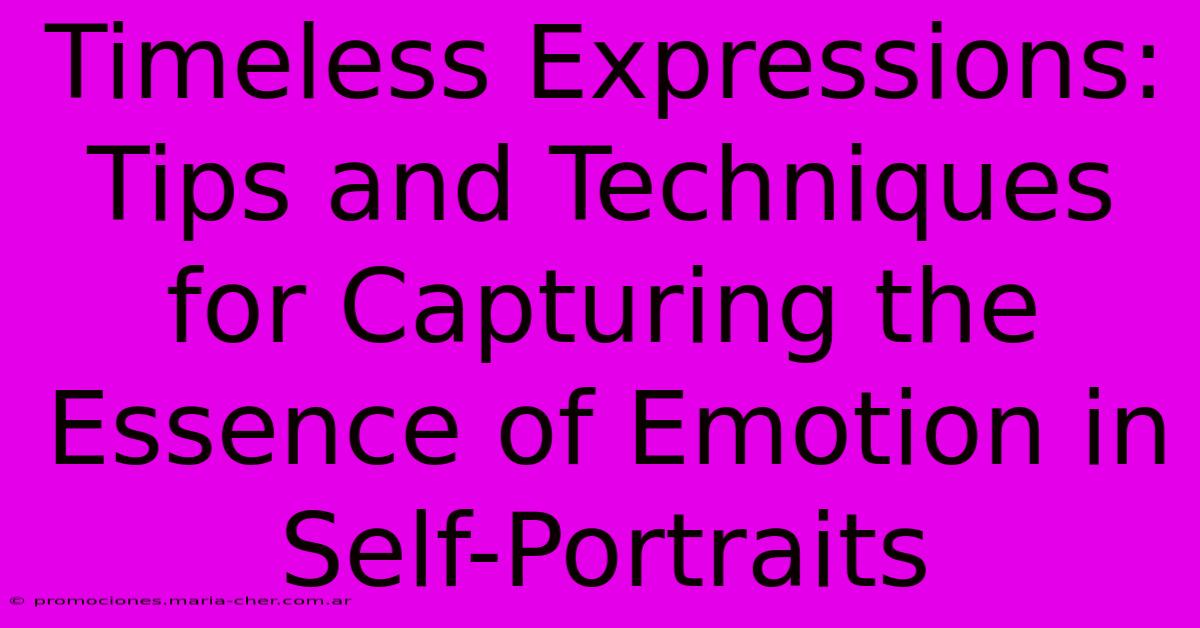Timeless Expressions: Tips And Techniques For Capturing The Essence Of Emotion In Self-Portraits

Table of Contents
Timeless Expressions: Tips and Techniques for Capturing the Essence of Emotion in Self-Portraits
Self-portraits offer a unique opportunity for self-expression and exploration. They're more than just a picture; they're a window into your soul, a visual diary of your emotional landscape. But capturing the essence of emotion – that fleeting moment of genuine feeling – requires more than just pointing a camera at yourself. This article delves into the art of creating compelling self-portraits that truly resonate, focusing on techniques and tips to help you convey authentic emotion.
Understanding the Emotional Landscape
Before even picking up your camera, consider the emotion you want to portray. Are you aiming for joy, sorrow, contemplation, or perhaps a complex blend? Understanding the nuances of emotion is crucial.
- Mood Boards: Create a mood board. Gather images, colors, and textures that evoke the desired emotion. This visual brainstorming session will guide your creative process.
- Journaling: Write about the emotion. Explore its triggers, its physical manifestations, and the internal sensations it evokes. This deeper understanding will inform your posing and expression.
- Music: Use music to set the mood. Play music that aligns with the emotion you wish to portray. This can be incredibly helpful in channeling the right energy.
Mastering the Technical Aspects
While emotion is paramount, the technical aspects of photography play a crucial role in bringing your vision to life.
Lighting:
- Natural Light: Natural light is your friend. Soft, diffused light creates a more flattering and evocative image. Experiment with different times of day – golden hour (sunrise and sunset) often produces magical results.
- Artificial Light: If you're working indoors, consider using a softbox or diffuser to avoid harsh shadows that can detract from the emotion.
Composition and Framing:
- Rule of Thirds: Don't center yourself perfectly. Use the rule of thirds to create a more visually appealing and dynamic composition.
- Cropping: Experiment with different crops. A tight crop on the face can emphasize minute expressions, while a wider shot can showcase your environment and its impact on your mood.
- Angles: Vary your camera angles. Shooting from slightly below can make you appear more powerful, while shooting from above can create a more vulnerable feeling.
Camera Settings:
- Aperture: A shallow depth of field (wide aperture like f/1.4 - f/2.8) can beautifully blur the background, drawing attention to your expression.
- Shutter Speed: A fast shutter speed freezes motion, capturing fleeting expressions. A slower shutter speed can create a sense of movement or blur, adding to the emotional impact (though you might need a tripod for sharper results).
- ISO: Keep your ISO as low as possible to avoid noise in your images, especially in low-light situations.
Techniques for Conveying Authentic Emotion
Authenticity is key. Forced expressions rarely translate well in self-portraits.
- Mirror Work: Practice your expressions in front of a mirror. This helps you become more aware of your facial muscles and how they contribute to different emotions.
- Method Acting: Think about a specific memory or situation that evokes the desired emotion. Allow yourself to genuinely feel it, and let that feeling translate into your expression.
- Body Language: Your body language plays a crucial role. Your posture, gestures, and overall body position can significantly enhance the emotional impact of your self-portrait. Don't forget the power of a subtle hand gesture or a meaningful gaze.
Post-Processing and Enhancement
Post-processing can enhance your self-portraits, but don't overuse it. Subtlety is key.
- Color Grading: Use color grading to set the mood. Cool tones often convey sadness or loneliness, while warm tones can suggest happiness or warmth.
- Black and White Conversion: Converting your image to black and white can sometimes amplify the emotional impact by removing distractions and focusing attention on the subject's expression and form.
- Retouching: Remove blemishes or imperfections subtly, but avoid over-retouching which can lead to an unnatural or inauthentic look.
Beyond the Technical: The Power of Storytelling
Your self-portrait is more than just a picture; it's a story. Consider the narrative you want to convey. What message do you want to share with the viewer? By thoughtfully considering the technical aspects, your emotions, and the storytelling potential, you can create timeless self-portraits that truly capture the essence of your inner world.
Remember, practice makes perfect. Don't be afraid to experiment, try different approaches, and most importantly, be true to yourself. The journey of capturing authentic self-expression is a continuous exploration – enjoy the process!

Thank you for visiting our website wich cover about Timeless Expressions: Tips And Techniques For Capturing The Essence Of Emotion In Self-Portraits. We hope the information provided has been useful to you. Feel free to contact us if you have any questions or need further assistance. See you next time and dont miss to bookmark.
Featured Posts
-
Natures Antibacterial Eucalyptus Leaves For A Healthier You
Feb 08, 2025
-
Create Floral Masterpieces Without Breaking The Bank Unmissable Discounts On Dried Flowers
Feb 08, 2025
-
Unveiling The Evolution Of The Mercedes Benz F1 Logo From Humble Beginnings To Global Icon
Feb 08, 2025
-
The Polaroid Size Spectrum A Comprehensive Guide For Picture Perfect Captures
Feb 08, 2025
-
Mind Games For Marketers How To Leverage Cognitive Biases For Success
Feb 08, 2025
